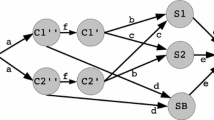Abstract
This paper describes a two-level simulated annealing heuristic for the joint problem of object placement and request routing in a Content Distribution Network (CDN) with constraints pertaining to server capacity and end-to-end object transfer delay. A CDN is a technology that is used to efficiently distribute electronic content throughout an existing network. The two-level solution procedure is composed of an outer and an inner simulated annealing algorithms. Computational experiments are conducted by comparing the proposed procedure with several truncated exact solution algorithms on randomly generated Internet topologies.

Similar content being viewed by others
References
Almeida JM, Eager DL, Vernon MK and Wright SJ (2004). Minimizing delivery cost in scalable streaming content distribution systems. IEEE T Multimedia 6: 356–365.
Bektaş T, Cordeau J-F, Erkut E and Laporte G (2008). Exact algorithms for the joint object placement and request routing problem in content distribution networks. Comput Opl Res doi: 10.1016/j.cor.2007.02.005.
Bektaş T, Oǧuz O and Ouveysi I (2007). Designing cost-effective content distribution networks. Comput Opl Res 34: 2436–2449.
Breslau L, Cao P, Fan L, Phillips G and Shenker S (1999). Web caching and Zipf-like distributions: Evidence and implications. In: IEEE Communications Society (ed) Proceedings of IEEE INFOCOM'99, Vol. 1. IEEE Computer Society Press: New York, pp 126–134.
Černý V (1985). Thermodynamical approach to the travelling salesman problem: An efficient simulation algorithm. J Optim Theory Appl 45: 41–51.
Chari K (1996). Resource allocation and capacity assignment in distributed systems. Comput Opl Res 23: 1025–1041.
Cidon I, Kutten S and Soffer R (2002). Optimal allocation of electronic content. Comput Network 40: 205–218.
Erçetin Ö and Tassiulas L (2003). Market-based resource allocation for content delivery in the Internet. IEEE T Comput 52: 1573–1585.
Fisher ML and Hochbaum DS (1980). Database location in computer networks. J Assoc Comput Mach 27: 718–735.
Gavish B and Suh MW (1992). Configuration of fully replicated distributed database system over wide area networks. Ann Opns Res 36: 167–192.
Hakimi SL and Schmeichel EF (1997). Locating replicas of a database on a network. Networks 30: 31–36.
Huang C and Abdelzaher T (2005). Bounded-latency content distribution: Feasibility and evaluation. IEEE T Comput 54: 1422–1437.
Johnson KL, Carr MS, Day JF and Kaashoek MF (2001). The measured performance of content distribution networks. Comput Commun 24: 202–206.
Kangasharju J, Roberts J and Ross KW (2002). Object replication strategies in content distribution networks. Comput Commun 25: 376–383.
Kirkpatrick S, Gelatt CD and Vecchi MP (1983). Optimization by simulated annealing. Science 220: 671–680.
Laoutaris N, Zissimopoulos V and Stavrakakis I (2004). Joint object placement and node dimensioning for Internet content distribution. Inform Process Lett 89: 273–279.
Laoutaris N, Zissimopoulos V and Stavrakakis I (2005). On the optimization of storage capacity allocation for content distribution. Comput Network 47: 409–428.
Li B, Golin MJ, Italiano GF, Deng X and Sohraby K (1999). On the optimal placement of web proxies in the Internet. In: Proceedings of IEEE INFOCOM'99, Vol. 3, New York, pp 1282–1290.
Nguyen TV, Safaei F, Boustead P and Chou CT (2005). Provisioning overlay distribution networks. Comput Network 49: 103–118.
Pirkul H (1986). An integer programming model for the allocation of databases in a distributed computer system. Eur J Opl Res 26: 401–411.
Qiu L, Padmanabhan VN, and Voelker GM (2001). On the placement of web server replicas. In: IEEE Communications Society (ed). Proceedings of IEEE INFOCOM'01, Anchorage, Alaska, Vol. 3, IEEE Computer Society Press: New York, pp 1587–1596.
Radoslavov P, Govindan R and Estrin D (2002). Topology-informed Internet replica placement. Comput Commun 25: 384–392.
Ryoo J and Panwar SS (2001). File distribution in networks with multimedia storage servers. Networks 38: 140–149.
Wauters T, Coppens J, De Turck F, Dhoedt B and Demeester P (2006). Replica placement in ring based content delivery networks. Comput Commun 29: 3313–3326.
Xu J, Li B and Lee DL (2002). Placement problems for transparent data replication proxy services. IEEE J Select Areas Commun 20: 1383–1398.
Xuanping Z, Weidong W, Xiaopeng T and Yonghu Z (2003). Data Replication at Web Proxies in Content Distribution Network, Lecture Notes in Computer Science, Vol.2642, Springer-Verlag: Xian, pp 560–569.
Yang M . and Fei Z (2003) A model for replica placement in content distribution networks for multimedia applications. In: IEEE Communications Society (ed). Proceedings of IEEE International Conference on Communications (ICC '03), Anchorage, Alaska. Vol. 1, IEEE Computer Press: New York, 557–561.
Zipf GK (1949). Human Behavior and the Principle of Least-Effort. Addison-Wesley: Cambridge, MA.
Acknowledgements
The first author is grateful to Dr Iradj Ouveysi for introducing him to the topic of content distribution, and to Vitória Pureza for helpful discussions on the simulated annealing algorithm. This research has been partially supported by a Strategic Project Grant of the Natural Sciences and Engineering Research Council of Canada (NSERC 2481). We gratefully acknowledge this support. We thank an anonymous referee who provided several valuable comments.
Author information
Authors and Affiliations
Corresponding author
Rights and permissions
About this article
Cite this article
Bektaş, T., Cordeau, JF., Erkut, E. et al. A two-level simulated annealing algorithm for efficient dissemination of electronic content. J Oper Res Soc 59, 1557–1567 (2008). https://doi.org/10.1057/palgrave.jors.2602490
Received:
Accepted:
Published:
Issue Date:
DOI: https://doi.org/10.1057/palgrave.jors.2602490




